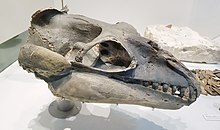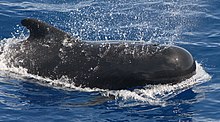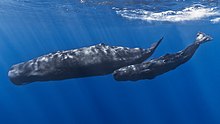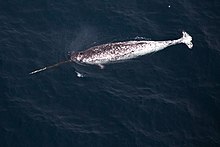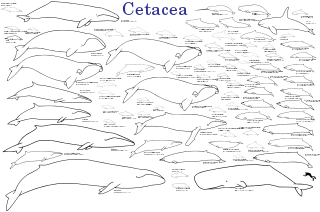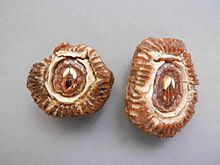Portal:Cetaceans
The Cetaceans Portal

Cetacea (/sɪˈteɪʃə/; from Latin cetus 'whale', from Ancient Greek κῆτος (kêtos) 'huge fish, sea monster') is an infraorder of aquatic mammals belonging to the order Artiodactyla that includes whales, dolphins and porpoises. Key characteristics are their fully aquatic lifestyle, streamlined body shape, often large size and exclusively carnivorous diet. They propel themselves through the water with powerful up-and-down movement of their tail which ends in a paddle-like fluke, using their flipper-shaped forelimbs to maneuver.
While the majority of cetaceans live in marine environments, a small number reside solely in brackish water or fresh water. Having a cosmopolitan distribution, they can be found in some rivers and all of Earth's oceans, and many species inhabit vast ranges where they migrate with the changing of the seasons.
Cetaceans are famous for their high intelligence, complex social behaviour, and the enormous size of some of the group's members. For example, the blue whale reaches a maximum confirmed length of 29.9 meters (98 feet) and a weight of 173 tonnes (190 short tons), making it the largest animal ever known to have existed.
There are approximately 89 living species split into two parvorders: Odontoceti or toothed whales (containing porpoises, dolphins, other predatory whales like the beluga and the sperm whale, and the poorly understood beaked whales) and the filter feeding Mysticeti or baleen whales (which includes species like the blue whale, the humpback whale and the bowhead whale). Despite their highly modified bodies and carnivorous lifestyle, genetic and fossil evidence places cetaceans as nested within even-toed ungulates, most closely related to hippopotamus within the clade Whippomorpha. (Full article...)
Selected picture

Dolphins have a streamlined fusiform body, adapted for fast swimming. The tail fin, called the fluke, is used for propulsion, while the pectoral fins together with the entire tail section provide directional control. The dorsal fin, in those species that have one, provides stability while swimming.
More did you know...
- ...when right whales and humpback whales breach (leap out of the water), seagulls can often be seen darting in to pick up pieces of skin that become dislodged from the breaching whales. Presumably this is an easy source of food for seagulls.
- ...whales and dolphins don’t sleep in the way humans do. Although we don’t know how they sleep, some scientists believe they sleep with half the brain asleep and half the brain awake, keeping them aware of danger.
- ...all whales and dolphins have the remains of the pelvis, but it is reduced to two small bones at the rear of the animal.
- ...the ‘strapped-toothed whale’ is so called because in mature males there are only two teeth in the bottom jaw and these completely ‘strap’ the upper jaw, preventing it from opening more than a few centimetres. How these animals eat is unknown, but it may be that they stun their prey with high intensity sound.
- ...some cetaceans can dive to depths of more than a kilometre and stay there for more than an hour.
Things you can do..
|
|
Here are some Cetaceans WikiProject tasks you can do.
|
General images -
Did you know (auto-generated)

- ... that the South Asian river dolphin is nearly blind and relies on echolocation for navigation?
- ... that one can swim with humpback whales in the Niue Nukutuluea Multiple-Use Marine Park?
- ... that one of the first researchers to propose dolphin-assisted therapy for humans later renounced it?
- ... that Celia Kaye won the Golden Globe Award for Most Promising Newcomer in 1965 for her starring role in Island of the Blue Dolphins?
Selected media
List articles
Related portals
WikiProjects

The content you are reading was created by Wikipedia volunteers. See WikiProject Cetaceans for more.
- See also: Wikispecies, a Wikimedia project dedicated to the classification of species.
Cetacean articles
Categories
For additional lists of marine life-related featured articles and good articles see:
Associated Wikimedia
The following Wikimedia Foundation sister projects provide more on this subject:
-
Commons
Free media repository -
Wikibooks
Free textbooks and manuals -
Wikidata
Free knowledge base -
Wikinews
Free-content news -
Wikiquote
Collection of quotations -
Wikisource
Free-content library -
Wikispecies
Directory of species -
Wikiversity
Free learning tools -
Wikivoyage
Free travel guide -
Wiktionary
Dictionary and thesaurus


